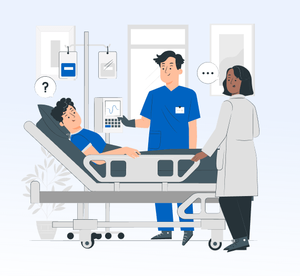Remote Patient Monitoring Software Development: Pioneering a New Era in Healthcare
الجسم
Introduction
Healthcare is rapidly evolving, thanks to advancements in technology, and one of the most significant breakthroughs is remote patient monitoring (RPM) software. This article delves into the world of remote patient monitoring software development, highlighting its transformative role in modern healthcare. We will explore the advantages it offers, the challenges it faces, and the exciting potential it holds for the future of patient care.
The Emergence of Remote Patient Monitoring Software
Remote patient monitoring software is a trailblazer in contemporary healthcare. It empowers healthcare professionals to remotely monitor and manage patients' health, presenting an innovative approach to patient care. This technology is particularly vital for individuals with chronic conditions, offering continuous, real-time monitoring and personalized healthcare.
Advantages of Remote Patient Monitoring
-
Enhanced Patient Care: RPM software allows healthcare providers to monitor patients' health continuously, facilitating timely interventions and more effective care.
-
Patient Empowerment: Patients become active participants in their healthcare, closely monitoring their vital signs and symptoms. This leads to a more informed and proactive approach to their health.
-
Preventive Healthcare: Continuous monitoring enables early detection of health issues, potentially reducing hospitalizations and healthcare costs.
-
Cost Efficiency: By reducing the need for frequent in-person visits, RPM software can lead to significant cost savings for both patients and healthcare systems.
-
Remote Care: Patients can receive quality care from the comfort of their homes, particularly crucial for those in remote or underserved areas.
Challenges in Remote Patient Monitoring Software Development
Despite the numerous advantages, RPM software development faces several challenges:
-
Data Security: Protecting sensitive patient data is paramount, necessitating the implementation of robust security measures to prevent data breaches.
-
Interoperability: Ensuring seamless communication between various devices and software systems is crucial for the success of RPM software.
-
User-Friendly Design: RPM devices and software must be user-friendly, catering to a diverse patient population, including older adults who may not be tech-savvy.
-
Regulatory Compliance: Adhering to healthcare regulations and standards is a complex but essential aspect of RPM software development.
The Promising Future of Remote Patient Monitoring
The world of remote patient monitoring software is in a state of constant evolution, with numerous advancements shaping its promising future:
-
IoT Integration: The Internet of Things (IoT) is facilitating the seamless connection of various medical devices and sensors, enhancing data collection and analysis.
-
Artificial Intelligence: AI-driven algorithms are becoming more sophisticated, offering predictive analytics and early detection of health issues.
-
Telemedicine Integration: The convergence of RPM software with telemedicine platforms enables real-time communication between patients and healthcare providers.
-
Wearable Technology: Smartwatches, fitness trackers, and other wearable devices are making remote patient monitoring more accessible and user-friendly.
-
Patient Engagement Tools: User-friendly patient portals enable patients to access their health data, monitor their progress, and communicate with healthcare providers.
Conclusion
Remote patient monitoring software development is revolutionizing healthcare. With benefits like enhanced patient care, cost efficiency, and patient empowerment, RPM software is a cornerstone of modern healthcare. While challenges such as data security and interoperability persist, ongoing advancements in IoT, AI, and telemedicine integration promise a bright future for RPM. As technology continues to evolve, remote patient monitoring is set to become a driving force in improving the quality and accessibility of healthcare for patients worldwide. It's an exciting time to witness the transformation of healthcare through remote patient monitoring software.













تعليقات